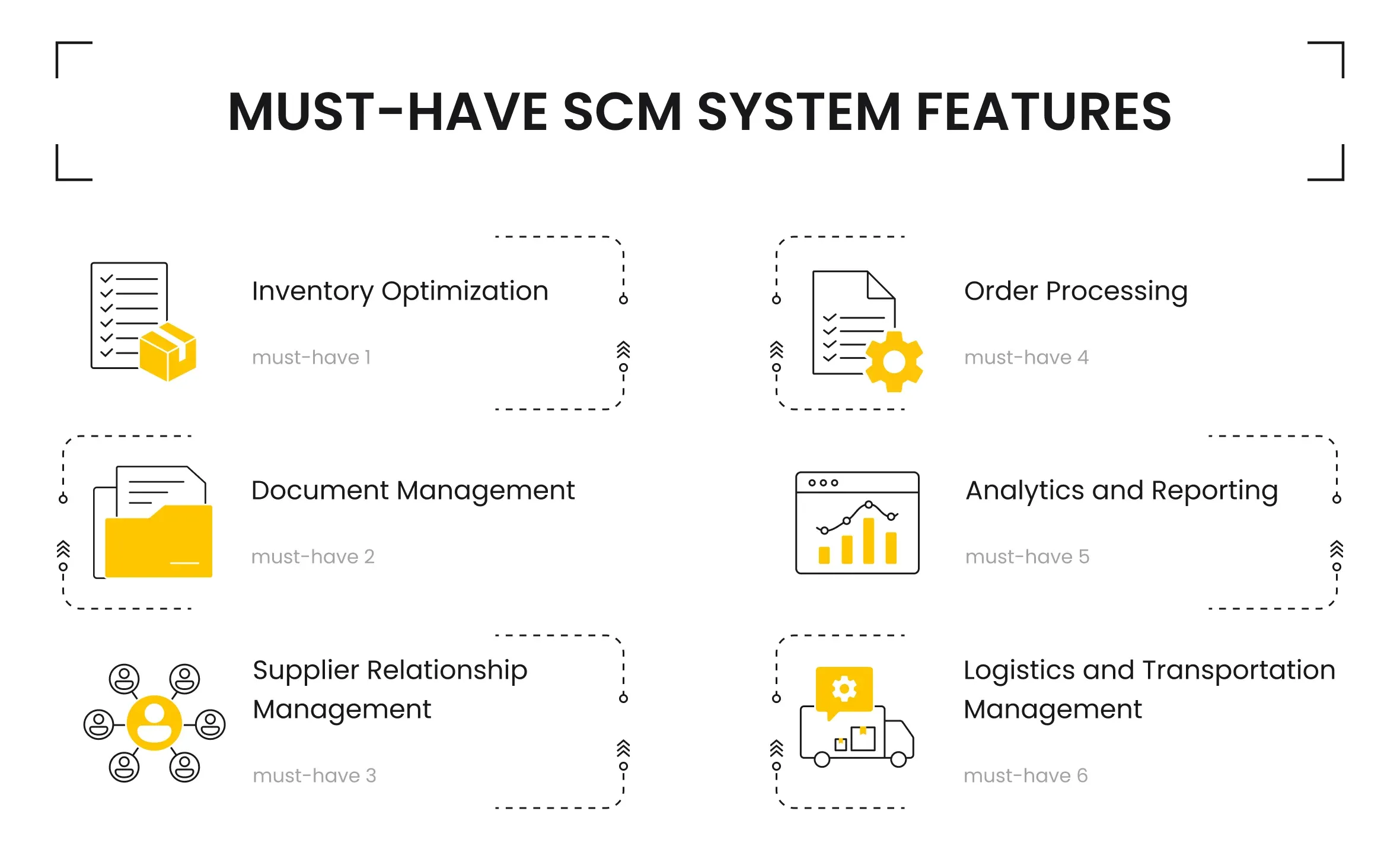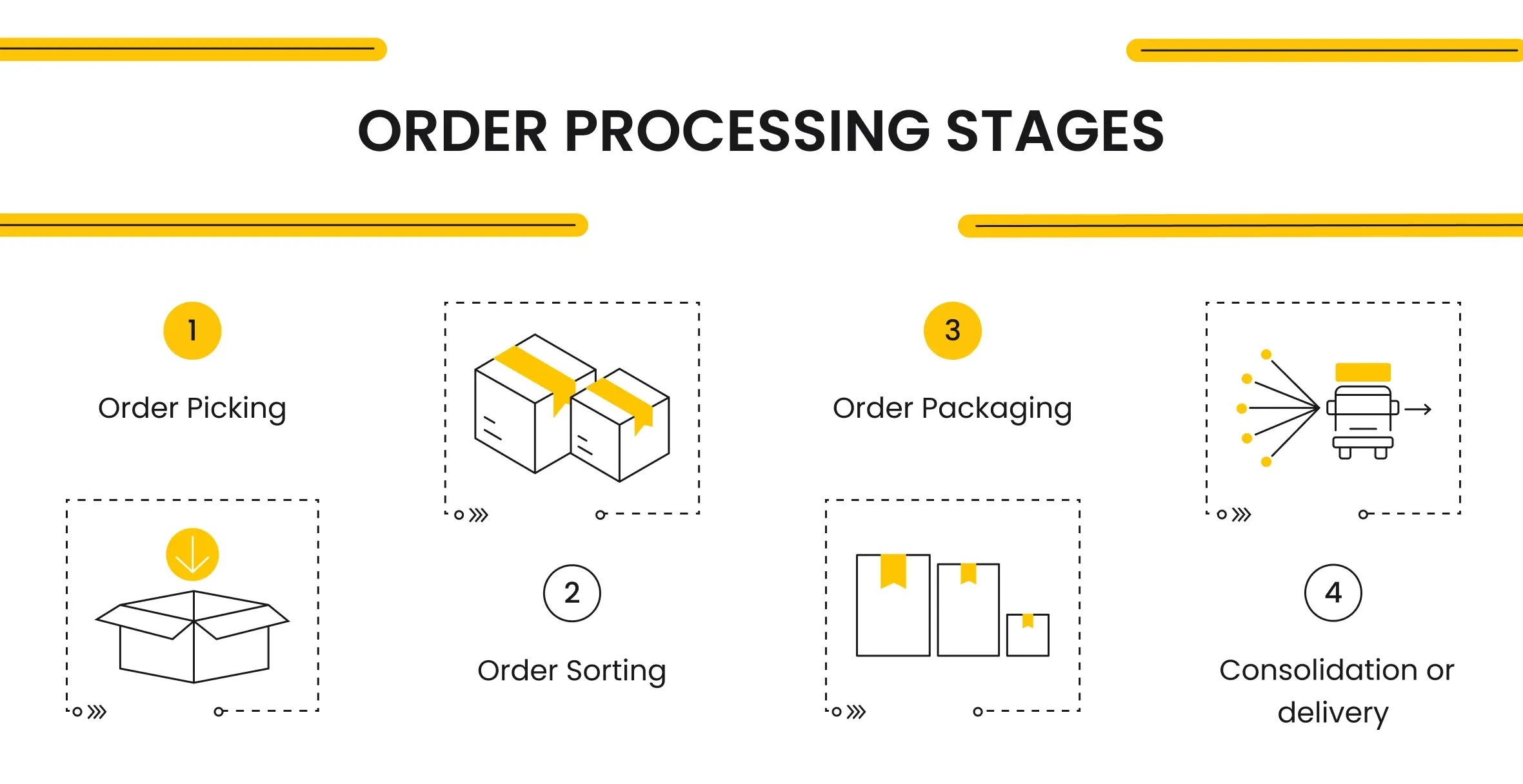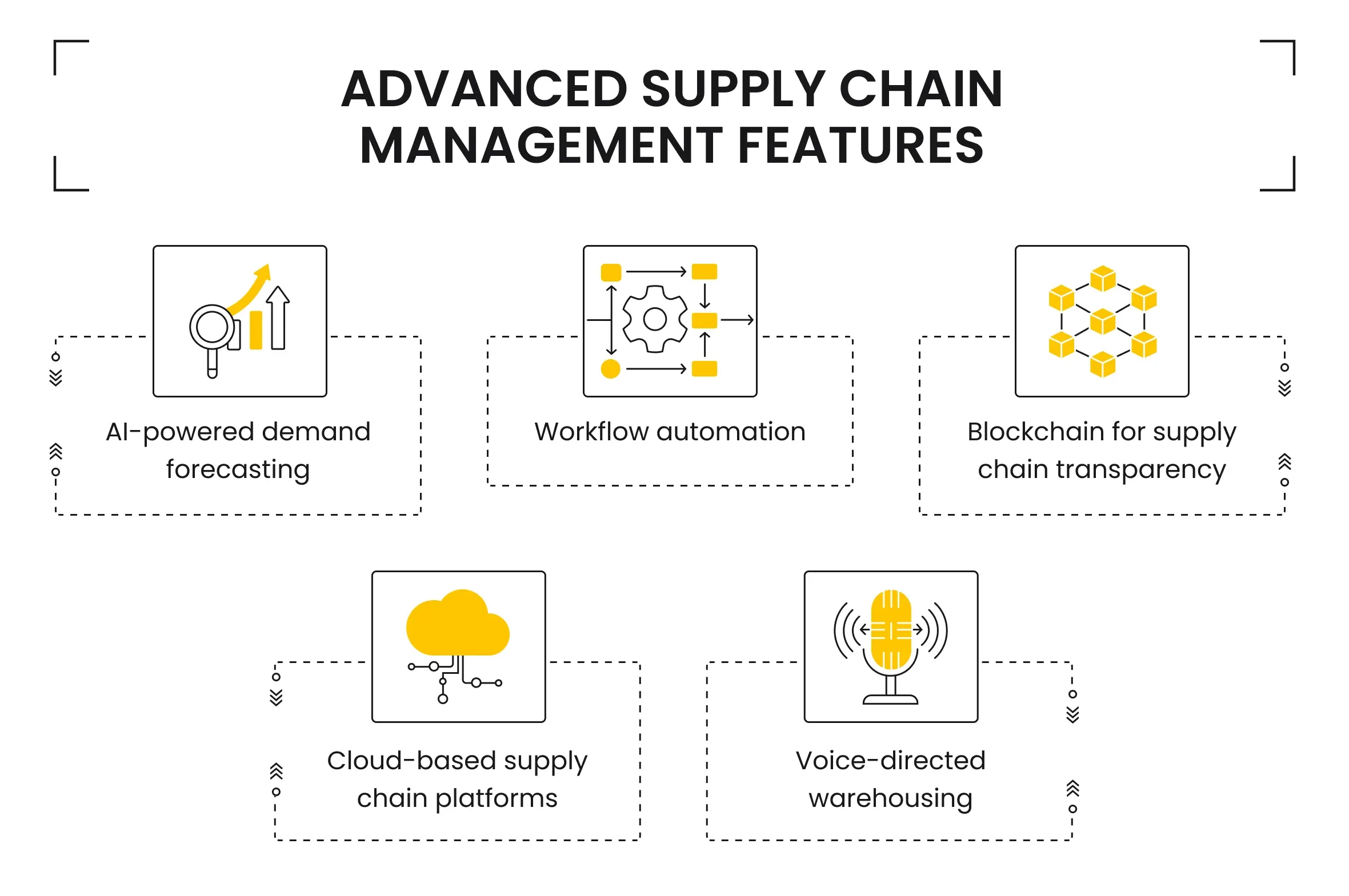Supply Chain
Top Supply Chain Management Software Features in 2025
February 27, 2025 • 169 Views • 18 min read
Bohdan Vasylkiv
CEO & Co-Founder
Supply chain software includes multiple robust solutions that help to upscale your logistics operations. Such software solution is usually a management system designed and used for various supply chain operations.
Nevertheless, to make the right choice and integrate a proper management solution, you should know what key features it must provide, depending on your business goals and logic. So, before discussing and choosing a supply chain management solution, we must first learn more about its options.
Must-Have Supply Chain Management Software Features

Such software solutions are capable of streamlining supply chain operations. Yet, such automation of supply chain processes and their efficiency varies, depending on the types of supply chain management you want to streamline.
For instance, it can be an inventory management and demand solution, also known as warehouse management. Alternatively, it can be an order management or operations management solution. Despite the overall resemblance, each SCM software solution has slight specifics that significantly impact the overall efficiency of process automation.
In fact, each supply chain management system is designed, developed, and trained differently to serve particular needs. Most solutions can cover the entire supply chain lifecycle, yet the accuracy and performance in different niches will vary.
Long story short, the core features of supply chain management systems include:
- Inventory Optimization
- Logistics and Transportation Management
- Supplier Relationship Management
- Document Management
- Order Processing
- Analytics and Reporting
Inventory Optimization
Any effective supply chain management includes inventory optimization. Long story short, inventory management is the backbone of any logistics business.
It is a set of methodologies, approaches, and strategies to ensure the efficiency of placed orders and the availability of offered goods. It helps to boost the customer experience by minimizing the arrival expectation date and ensuring efficient supply.
Besides, inventory management software simplifies monitoring the available goods and resources, tracking their deliveries, and satisfying the potential demand by adjusting the warehouse storage and content.
Simply put, effective inventory management and optimization are data-based processes used to analyze supply and demand so that logistics businesses won't store too much or too few goods in their warehouses.
Clearly, it is essential to optimize supply companies' storage, ensuring they are neither overcrowded with goods nor completely empty. Otherwise, such companies will have higher expenses.
Finally, any efficient supply chain is global: it includes multiple warehouses in different regions to cut the delivery time and cover various areas and their demands. In fact, apart from warehouse management, this aspect also relies heavily on transportation administration.
Logistics and Transportation Management
Parcel tracking and other transportation management services are among the must-have features of any common supply chain.
Long story short, it tracks the deliveries, designs efficient routes, relocates goods and inventory, plans and implements efficient infrastructure, etc.
Software options for transportation help to track the efficiency of cooperation between supply chain partners, satisfying the business needs and expectations of each party across the supply chain.
Efficient transportation helps businesses to save time, costs, or other resources like human labor. Modern management software is essential to achieve the highest possible results in transportation. Modern transportation companies can achieve much higher results thanks to the Internet of Things, the improvement of tracking devices, and the best supplier management practices.
Once again, SCM suggests interconnections across your supply chain. Therefore, to ensure the efficiency and accuracy of data, it is designed and operated as a centralized platform. So, in addition to transportation management, your supply chain professionals can and must update the supplier relationship data.
Supplier Relationship Management
Such supply software also helps optimize your connections and contacts. For instance, supplier relationships must be monitored and updated along the supply chain at each crucial stage.
In a nutshell, your team must file and report all its interactions with supply vendors or other third parties along the way, giving honest and detailed feedback on each activity. Gathering such data, processing, and analyzing it help to enhance risk management and the overall quality of the services offered.
Such routine yet effective practices help to define potential bottlenecks or other unoptimized processes within logistics. Fortunately, modern software can help speed up such processes and streamline parts of them.
Reporting and feedback are off the table and still must be done by the employees. However, using software for your business can easily automate data processing and analysis.
Document Management
The number of operations that software enhances also includes documentation.
Documentation management is yet another critical aspect of supply business. Such operations define the overall business clarity and play a key role in many other operations. Frankly, documentation management involves storing files or other documents and dealing with data and different types of information circulating within the supply chain.
Fortunately, data management software offers a robust number of best practices and advanced tools to ensure the efficiency of such processes, allowing the efficient streamlining of almost all supply chains and operations related to data or any other information within your business.
As a result, companies significantly reduce costs and mitigate risks by integrating software-based data management tools that help to efficiently and quickly gather, process, and sort data inputs. Moreover, it can be used for further advanced operations like market predictions or other prognosis.
Order Processing

Order processing involves a few different operations related to a customer's request. To simplify, there are four important steps of order processing:
- Picking
- Sorting
- Packaging
- Consolidation or delivery
First, it suggests displaying available goods on the marketplace or other platforms clients use. Yet, this involves not only displaying selling options but constantly checking if they are present in the warehouse, defining which storage can supply the request, planning the delivery process, etc.
Multiple orders from neighboring areas are sorted together and delivered to the customers to optimize the delivery.
Still, at the sorting stage, it is vital to identify and package each independent parcel, ensuring it is going to its customer. The packaging process also assumes weighing, labeling, and wrapping each parcel. Finally, orders are packed together and delivered to each client after everything is wrapped and ready to go.
Supply chain software is essential if you want to have clear and relevant information on every step, as well as the status of each independent parcel. Previously, such functionality was primarily used within the delivery company. Yet, nowadays, most businesses offer parcel tracking as a feature to their customers, providing them with information about the stage of the order.
Long story short, all you need to ensure seamless and efficient order processing is to develop or integrate a reliable SCM that suggests your employees update each stage in-app.
To rephrase, your employees should only update their working status in the system, and the rest of the assumptions and calculations are usually performed by software solutions under the hood.
Analytics and Reporting
Last but not least, software should be able to conduct analytics and reporting. We already explained why software is data-driven and that any of your solutions must have access to logistics management metrics and related information.
Thanks to such access and computation capabilities, built-in software helps track and monitor multiple working aspects and processes, as well as provides businesses with more detailed information about ongoing tasks and operations.
To sum up, the foregoing list includes not just top features of supply chain but essential functionality that must be present in any SCM solution. Fortunately, such a toolset is a widespread practice and standard for any supply chain software development services. Basically, all you need to do is find a reliable development company, and it will most likely provide you with a corresponding software product.
However, this doesn't mean that you should limit yourself to just the basic version of SCM. Quite the opposite: if you decide to build a custom supply chain solution over SaaS or other ready-made platforms, you should consider creating an advanced supply chain management software to be even more competitive and bring more value to your business.
Advanced Supply Chain Management Features

Simply put, the easiest and most efficient way to create an advanced logistics and transportation management system - is to use and integrate innovative technologies and methodologies that have proven their efficiency. Among such modern trends in supply chain software scaling, we can name at least a few key features for better product lifecycle management:
- AI-powered demand forecasting
- Workflow automation
- Blockchain for supply chain transparency
- Cloud-based supply chain platforms
- Voice-directed warehousing
Depending on your needs and business specifics, you can consider integrating one of the solutions to increase your SMC efficiency.
Based on our experience, each of such trends has enough reasons to exist, bringing a lot of value if implemented correctly.
AI-Powered Demand Forecasting
Artificial intelligence is a powerful and popular software among many modern businesses. Thanks to the open-source nature of AI, such as ChatGPT and Gemini, or their alternatives, businesses can easily upscale their services without spending a lot of resources creating a new model.
All you have to do is find the most suitable model and integrate it via API. Still, apart from implementing the AI, you must spend time and resources on training to achieve the expected results.
One of the most potent advantages of such an approach is its simplicity: you can hire just a few software developers familiar with AI technologies to perform integration and optimization.
Besides offering ways to automate multiple processes like customer support, AI integrations can significantly improve your supply chain performance using more advanced algorithms such as demand forecasting.
Long story short, AI is a data-driven solution capable of defining patterns. So, with proper training, data access, and monitoring by skilled employees, it can become a deal-breaker for logistics businesses, allowing them to analyze and define patterns and build forecasts based on these findings.
Workflow Automation
Another popular solution is streamlining undergoing processes and operations. As a matter of fact, there are multiple tools and methodologies to perform such tasks even without software.
Still, a digital supply chain can offer even more solutions to streamline multiple processes, increasing business ROI and saving efforts. For instance, it can be combined with the previously mentioned AI business integration to achieve even better cost-efficiency and performance.
Blockchain Transparency
Another example of the future of supply chain businesses is blockchain integrations. Blockchain is a technology that defines data storing and transferring practices, suggesting ways to ensure high protection and transparency of the operated information. Besides, it can be used for workflow automation.
One of the most suitable examples is smart contracts. These digital agreements are based on algorithms and can be used to:
a) ensure each side of the agreement fulfills its obligations b) automate the contract processes such as payments, closing deals, etc.
Cloud-Based Supply Chain Software
Yet another example of the future of supply chain management is migration to the cloud. With IoT principles and seamless data transfers, cloud-based software helps reduce IT infrastructure expenses while delivering excellent results.
Besides, cloud services like AWS offer high-security measures and overall protection of your system and provide its customers with extra services and features that are much more expensive and complex to develop otherwise.
Voice-Directed Warehousing
Finally, using AI integrations, businesses can enable voice-operated management systems. Therefore, companies can offer more valuable and fast ways to update information or enable SCM to answer requests on the spot.
Frankly, at the moment, it will work as an additional feature that is not vital for the overall performance of your system. Still, it is impossible to predict how it can transform supply chain management in the future due to the lack of real-life use cases for such tech in this industry.
Choosing the Right Custom Supply Chain Management Software in 2025
Summing up all the above, the modern situation in this market is biased. On the one hand, it is hard to argue the importance of supply chain development and improvement. However, most innovative solutions are still under development and integration.
Still, if you ask us how to find the right supply chain network, we have an answer: consider a custom software development project.
Unlike conventional application development, the custom approach aims to satisfy all potential business requests and needs. So, apart from key features of supply chain, companies can plan and implement more sophisticated and rare services or functionalities like AI-driven decision-making and risk management, advanced market analysis and demand predictions, etc.
For more details - contact us, and we will gladly help you build a resilient supply chain management solution!
What’s your impression after reading this?
Love it!
1
Valuable
1
Exciting
1
Unsatisfied
1
FAQ
Let us address your doubts and clarify key points from the article for better understanding.
How does predictive analytics help in supply chain risk management?
Predictive analytics helps supply chain risk management by using data, statistical models, and machine learning to anticipate potential disruptions. It enables businesses to identify risks like demand fluctuations, supplier delays, and transportation issues in advance, allowing for proactive decision-making, optimized inventory management, and improved resilience against uncertainties.
Why should businesses choose cloud-based supply chain solutions?
Businesses should choose cloud-based supply chain solutions for scalability, real-time visibility, cost efficiency, and enhanced collaboration. These solutions improve data accessibility, streamline operations, and enable faster decision-making while reducing IT infrastructure costs and increasing adaptability to market changes.
How does warehouse automation benefit supply chain management?
Warehouse automation enhances supply chain management by improving efficiency, reducing errors, and lowering labor costs. It speeds up order fulfillment, optimizes inventory management, and increases accuracy, leading to faster deliveries and improved customer satisfaction.
How is AI helping businesses create more sustainable supply chains?
AI helps businesses create more sustainable supply chains by optimizing routes, reducing waste, and improving resource efficiency. It enables better demand forecasting, minimizes excess inventory, and enhances energy efficiency, leading to lower carbon footprints and more eco-friendly operations.
you may also like
Let’s talk!
This site uses cookies to improve your user experience. Read our Privacy Policy
Accept
Share this article